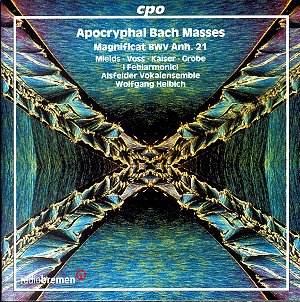The
catalogue of Bach's works contains several pieces which once were
attributed to Bach - mainly on the basis of the handwritings of
the manuscripts, which were either by Bach himself or by people
from his circle, who often acted as copyists. Later musicological
research has shown that these works were merely copied for performing
reasons, but were actually composed by others.
The
German conductor Wolfgang Helbich has recorded apocryphal works
before: a 2-CD set with spurious cantatas, a CD with motets and
the St Luke Passion. The latest recording in this project is devoted
to two Masses and a setting of the Magnificat.
The
Masses are of the 'missa brevis' type, consisting of Kyrie and
Gloria only - just like Bach's own Missae breves (BWV 233 - 236).
The composer of the Missa in C (BWV Anh 25) is still unknown,
but is thought to be a German composer in Dresden, who was influenced
by the Italian style before Pergolesi. That assumption can be
justified on the basis of the close connection between text and
music. In the Christe eleison, for example, the prayer for mercy
to Christ in heaven is symbolised by the upward moving scale,
played by the violins, creating a rhetorical figure, which is
called 'suspiratio'. In the Domine Deus the section about God
the Father is sung by the tenor, the section about God the Son
by the alto. At the end both are mentioned: "Lord God, Lamb of
God, Son of the Father" - appropriately here both voices join
each other. There are two fugues in this mass setting: at the
end of Kyrie II and Cum Sancto Spiritu at the end of the work.
It is not difficult to see why Bach was interested in this piece.
The
Mass in c minor (BWV Anh 26) was written by Francesco Durante.
Unlike in the Mass in C major Bach made some changes here: he
composed new music for the Christe eleison - a duet for soprano
and alto - and Durante's music for the first section of the Gloria
was transferred to the Kyrie II and replaced by a plainchant intonation.
In this work the relationship between text and music isn't as
close as in the first mass setting. The third item on this CD
- placed between the Missae breves - is an intimate setting of
the Magnificat - on German text -, for soprano, transverse flute,
2 violins and basso continuo. In the 19th century it was attributed
to Bach, but later a German musicologist considered it a composition
by Telemann. This claim seemed to be supported when it was discovered
that the work was closely connected to the Neue Kirche in Leipzig,
where Telemann was organist and director of music until 1705.
But more recently the true identity of the composer was established:
Melchior Hoffmann, who is also considered the composer of the
cantatas 53 and 189 in the Bach Werke Verzeichnis. He succeeded
Telemann in the Neue Kirche in 1705. It is a small scale work
in the rhetorical tradition of German sacred music. We find here
melismas to stress key words, like ‘mächtig’ (mighty), repetition
to illustrate ‘währet immer für und für’ (endures
for ever), strong accents in the basso continuo on the verse ‘Er
stösset die Gewaltigen vom Stuhl’ (he has put down the mighty
from their seats) and a sudden modulation on ‘fürchten’ (fear).
Some
people believe that sacred music in the Germany of Bach's time
was usually performed with one voice per part. This theory is
controversial and subject of an on-going debate. But one doesn't
need to embrace that theory to hold the view that a choir of 34,
like the Alsfelder Vokalensemble in this recording, is simply
too big. There is a lack of clarity and flexibility in the choral
singing, even though the qualities of the choir are undeniable.
In fact, the performance of the choir is pretty good, but it could
even have been better if the choir had been about half the size
- in accordance with the 'traditional' view of the kind of choir
Bach had at his disposal. Only the Magnificat by Hoffmann is performed
on the small scale the work so clearly asks for.
There
is a strange discrepancy between the liner notes by Peter Wollny
and the actual performance. Regarding Durante's Mass in c minor,
Peter Wollny states: "In its original form the serious, melodically
somewhat brittle, yet harmonically bold work has an orchestra
consisting merely of two (tutti) violins and continuo. Therefore,
the three choral parts are reinforced by trombones in order to
fit out the middle range. It is not known, however, whether this
change expanding the instrumentarium was undertaken by Bach or
adopted by him from his source". But where are the trombones in
this recording? I haven't heard them, and no trombones are mentioned
in the list of players. Perhaps these parts are played here by
strings, but with the choir being as large as it is that is impossible
to tell. By the way, the orchestra is playing very well.
Most
of the soloists are good; in particular the duets of soprano and
alto are very well realised. I am less impressed by the bass Rolf
Grobe: his singing is a little rough and lacks subtlety.
The
booklets of CPO recordings are always of a very high standard:
the lyrics are printed in the original and in English translation,
all members of choir and orchestra are listed. And the liner notes
are informative and well-written.
My
reservations don’t hold me back from recommending this recording.
As far as I know there are no other recordings of the Masses available,
and Hoffmann’s Magnificat is performed here better than by Joshua
Rifkin’s Bach Ensemble.
Johan
van Veen
